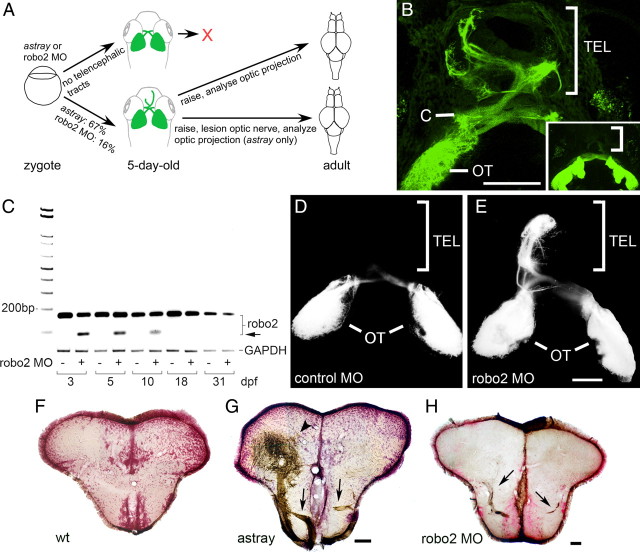Figure 1.
Pathfinding errors in the optic projection are retained in adults in astray mutants and in robo2 morphants. A, Experimental paradigm. Living 5-d-old larvae were preselected for the presence of aberrant telencephalic optic tracts and raised for adult experiments as indicated. B, Dorsal views are shown (rostral is up). Living astray larvae were selected according to the presence of GFP-positive optic axons in the telencephalon (TEL). Inset shows a wild-type projection without telencephalic tracts. (C, chiasm; OT, optic tectum). Brightly labeled neuromasts have been removed from the projection for clarity. C, PCR analysis of robo2 mRNA expression with and without robo2 splice-blocking morpholino (MO). The morpholino reduces the abundance of the wild-type transcript and an erroneous transcript (arrow) becomes detectable through at least 10 dpf. Glyceraldehyde-3-phosphate dehydrogenase is used as an internal standard. D, E, Dorsal views of DiI-traced optic projections (rostral is up) indicate astray-like pathfinding errors in robo2 morpholino-injected (E), but not in control morpholino-injected (D) 5-d-old larvae. The ectopic projection to the telencephalon is mainly unilateral. F–H, Photomicrographs show optic axons (brown) in cross sections of the adult telencephalon (counterstained in red); dorsal is up. Ectopic tracts of optic axons (arrows in G, H) are present in the telencephalon of astray (G) and robo2 morphant (MO) animals (H), but not in wild type (F). The arrowhead in G indicates a dense termination area of ectopic optic axons in the dorsal telencephalon. Scale bars: B, 100 μm (250 μm for inset); D, E, 100 μm; F, G, 200 μm; H, 100 μm.

